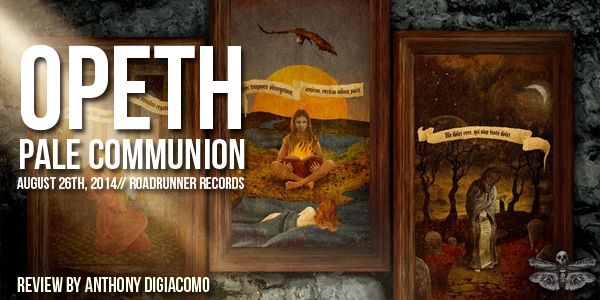
When the announcement was made that Opeth frontman Mikael Akerfeldt was not doing harsh vocals on 2011’s Heritage, fans were instantly torn. While some embraced the idea thanks to the phenomenal Damnation, which also featured no harsh vocals, most fans were skeptic. To the discontent of many, Heritage was far from Damnation 2.0, and those hoping Pale Communion may be that album may feel let down once again. Pale Communion is not a heavy album, despite early press saying otherwise, nor is it an iteration of Heritage . Pale Communion is a logical step back to writing songs that sound like the Opeth many fans missed while clinging to the sound and feel of Heritage. Pale Communion is another entry in a relatively contained movement of regressive rock, of which artists such as Steven Wilson and Ghost B.C. have also been contributing to. A kind of throwback to 70’s prog rock that is more than just a nod to or driving influence in the music, but rather a full on attempt at recapturing a time long past.
On the surface, this album is a more upbeat, melodic Heritage; but under the hood it’s more traditionally Opeth than its predecessor. The song structures, chord voicings, and addition of occasional riffs that recall the Opeth of the past help drive the album away from being just another Heritage. However, the lack of distortion on said riffs detracts from what could have been a striking dynamic within tracks such as ‘River’ and ‘Moon Above, Sun Below’. ‘River’ itself stands above the rest of the album as a kind of anthemic rock song via heavy Kansas influence, eventually changing gears part way through and progressing to a very metal sounding section that is neutered by the lack of heavier distortion to accentuate it.
‘Moon Above, Sun Below’ could have been the most “Opeth” song in two albums if the “heavy” parts were accented with the use of slightly more gain on the guitars. The gorgeous acoustic interlude punctuated with lightly gained lead work adds nicely to the vibe and brings the listener back to Watershed and Ghost Reveries days; though an extremely awkward, and almost forced sounding acapella section about midway through breaks pace and leaves a sour taste. The part in question feels as if Mikael were trying to channel every last obscure element of 70’s prog and one final puzzle piece revealed itself to him.
Pale Communion‘s more upbeat nature may be its strongest point, with only a few songs dipping into slow territory, and most having a good balance between the two. ‘Goblin’ in particular is something different for Opeth, an instrumental beginning with a delayed clean guitar tied off with additional layers of intrigue popping up during the course of the track. To the discredit of the album, a handful of songs sound as if they could have been a Steven Wilson solo project song, with Akerfeldt vocals. This lack of identity may be a deciding factor for or against the album for some fans.
In the end, Pale Communion pales in comparison to Opeth’s releases of the past. It lacks the identity and overall variety older albums had. While the lack of harsh vocals may put off some fans, they aren’t always a needed addition to metal. Pale Communion has set the gears in motion for Opeth to get back to writing the kind of music that truly set them apart in the music world but requires a few more distinct and unique touches from the past to really be considered a worthy addition to their repertoire.
Opeth’s Pale Communion gets…

3.5/5
-AD